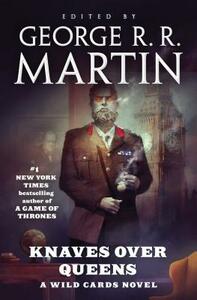Take a photo of a barcode or cover
I like all the Wild Cards books, but this one was extra fun as it covered the whole history of the Wild Card virus in the UK. There was a lot more detail about a few things that were previously in the background (Queen Mary) and some of the stories take place around the edges of stories from earlier books. Lots of new authors too like Stross and Cornell.
adventurous
mysterious
fast-paced
adventurous
medium-paced
Plot or Character Driven:
Character
Strong character development:
Yes
Loveable characters:
Yes
Diverse cast of characters:
Yes
Flaws of characters a main focus:
Complicated
Like most anthologies, some stories were very good; others, less so. One I could not force my way through.
I discovered this series about the same time I began reading A Song of Ice and Fire, and found this different world just as inviting. The mixture of past events in a world of aces and jokers was too much to resist.
“Knaves Over Queens,” originally released in 2018, is the story of England and their experiences with the virus that can produce good and bad results in people. I might have been hoping for more with this book and like the virus, I found a mixture of positives and negatives.
First off, the actual writing by the various authors is very good, although some of the characters are a bit hollow. Perhaps it is due to the many previously published books and the idea that aces will do good things and be heroes which caused this dissatisfaction. Little wonder, then, that the quirkier characters were my favorites.
The book is a collection of stories that take place over seven decades, which causes the British storyline to lose some cohesion. While there is some minimal interaction between characters, the only time definite continuation occurs is when a few of the authors contribute more than one story, and they pick up the trail of their characters years later. Some of these characters were not my favorites, especially one series which features a female who identifies as a Celtic goddess.
There are also many imaginative stories, such as Emma Newman’s “How to Turn a Girl to Stone” and “Night Orders by Paul Cornell. There are a few stories with references to famous musicians, and Mr. Cornell’s David Bowie appearance is fun as well as creative (without spoiling, Bowie takes some advice and performs an about-face with his musical direction, a positive step though different from our reality). My favorite story: “The Visitor,” by Mark Lawrence, who creates a most unlikely hero in perhaps what is the most creative story in the book.
Bottom line: While this may not be the best book in the Wild Card universe, it has appeal and contains a few gems. Four stars.
“Knaves Over Queens,” originally released in 2018, is the story of England and their experiences with the virus that can produce good and bad results in people. I might have been hoping for more with this book and like the virus, I found a mixture of positives and negatives.
First off, the actual writing by the various authors is very good, although some of the characters are a bit hollow. Perhaps it is due to the many previously published books and the idea that aces will do good things and be heroes which caused this dissatisfaction. Little wonder, then, that the quirkier characters were my favorites.
The book is a collection of stories that take place over seven decades, which causes the British storyline to lose some cohesion. While there is some minimal interaction between characters, the only time definite continuation occurs is when a few of the authors contribute more than one story, and they pick up the trail of their characters years later. Some of these characters were not my favorites, especially one series which features a female who identifies as a Celtic goddess.
There are also many imaginative stories, such as Emma Newman’s “How to Turn a Girl to Stone” and “Night Orders by Paul Cornell. There are a few stories with references to famous musicians, and Mr. Cornell’s David Bowie appearance is fun as well as creative (without spoiling, Bowie takes some advice and performs an about-face with his musical direction, a positive step though different from our reality). My favorite story: “The Visitor,” by Mark Lawrence, who creates a most unlikely hero in perhaps what is the most creative story in the book.
Bottom line: While this may not be the best book in the Wild Card universe, it has appeal and contains a few gems. Four stars.
Ever since I was a little girl watching X men cartoons I've been a sucker for mutants so when I heard that G. Martin compiled and wrote short stories about a virus giving people extra ordinary abilities it was a no brainer that I would submerge myself in these volumes. I liked the way the stories, while written by different authors, have been combined in a style similar to WWZ, which I loved, and how we hear a story from more than one point of view and how certain secondary characters become central characters in other stories where we meet former central characters that have now taken a secondary or cameo role and thus the story is carried on. I also found it cool that the scientific problem of mutant powers has been approached and even though explanations have not been found for every problem and defiance of physic's law, there seems to be a want to search for further reasons.
Not my cup of tea - probably because of when it was written, but it felt outdated and irrelevant and at its worst - boring.
"Dzikie Karty" sygnowane nazwiskiem George R.R. Martina skończone. Cóż by o tym napisać, żeby Was zachęcić a jednocześnie pozostać szczerym i tą szczerością Was nie zniechęcić. Przede wszystkim chciałbym, abyście wszyscy wydali pieniądze na tą antologię, aby Zysk i S-ka mieli dość zysku, aby wydać kolejne tomy. Dlaczego?
Przede wszystkim dlatego, że pierwszy wolumin "Dzikich kart" wprowadza na "arenę" uniwersum bohaterów, którzy w późniejszych tomach tego "współdzielonego" przez różnych autorów uniwersów dorobią się autonomicznych powieści. Tutaj mamy do czynienia - w większości opowiadań - z (trzymając się komiksowego żargonu) "orgins" postaci. Jedne są ciekawe bardziej, inne mniej, ale praktycznie żadna z nich nie ma szansy na pokazanie czegoś więcej niż to, że właśnie odkryła w sobie super-moc i... ojeju, co z tym dalej? Choć jest kilka wyjątków (zwłaszcza w okresie obejmującym lata 1946 - 1950+ linii fabularnej tego alternatywnego uniwersum, oraz co-nie-co w końcówce [lata 70-te]) to jednak bohaterowie "nabierają wiatru w żagle" dopiero w kolejnych odsłonach cyklu "Dzikie karty" i fajnie by było, gdyby polski czytelnik mógł tego doświadczyć.
Dla fanów komiksów jest to rzecz nieoceniona. "Dzikie karty" zaistniały początkowo, jako "szkielet" do stworzenia gry fabularnej, w którą po kilku piwkach pogrywali sobie G.R.R. Martin i przyjaciele piszący do, hm, może nie "pulpowych", ale coś w ten deseń ;) magazynów science-fiction, by w ostatecznej formie rozrosnąć się do obszernego uniwersum portretującego alternatywną historię, w której w roku 1946 pojawili się, hm, super-bohaterowie i super-złoczyńcy. Co zrobiłby Supermen postawiony przed komisją Herberta Hoovera? Czy Flash byłby w stanie zapobiec zimnowojennemu kryzysowi z 1960 roku? I czy polski super-imigrant Wojtek Grabowski jest w stanie powstrzymać posthipisowską falę dowodzoną przez Króla Jaszczura (alter ego Jima Morrisona) i Radykała? Tego wszystkiego dowiecie się z "Dzikich Kart".
"Dzikie karty" ukazały się niemal równolegle z "Watchmen" Alana Moore'a, co dowodzić może tylko tego, że był to okres, w którym zapotrzebowanie na poważniejsze podejście do etosu superbohatera komiksowego musiało w końcu znaleźć ujście. Jednym z tych kanałów jest właśnie ta antologia. Nie powala na kolana, ale jako początek - z nadzieją na mocniej ugruntowane fabularnie - może być.
Przede wszystkim dlatego, że pierwszy wolumin "Dzikich kart" wprowadza na "arenę" uniwersum bohaterów, którzy w późniejszych tomach tego "współdzielonego" przez różnych autorów uniwersów dorobią się autonomicznych powieści. Tutaj mamy do czynienia - w większości opowiadań - z (trzymając się komiksowego żargonu) "orgins" postaci. Jedne są ciekawe bardziej, inne mniej, ale praktycznie żadna z nich nie ma szansy na pokazanie czegoś więcej niż to, że właśnie odkryła w sobie super-moc i... ojeju, co z tym dalej? Choć jest kilka wyjątków (zwłaszcza w okresie obejmującym lata 1946 - 1950+ linii fabularnej tego alternatywnego uniwersum, oraz co-nie-co w końcówce [lata 70-te]) to jednak bohaterowie "nabierają wiatru w żagle" dopiero w kolejnych odsłonach cyklu "Dzikie karty" i fajnie by było, gdyby polski czytelnik mógł tego doświadczyć.
Dla fanów komiksów jest to rzecz nieoceniona. "Dzikie karty" zaistniały początkowo, jako "szkielet" do stworzenia gry fabularnej, w którą po kilku piwkach pogrywali sobie G.R.R. Martin i przyjaciele piszący do, hm, może nie "pulpowych", ale coś w ten deseń ;) magazynów science-fiction, by w ostatecznej formie rozrosnąć się do obszernego uniwersum portretującego alternatywną historię, w której w roku 1946 pojawili się, hm, super-bohaterowie i super-złoczyńcy. Co zrobiłby Supermen postawiony przed komisją Herberta Hoovera? Czy Flash byłby w stanie zapobiec zimnowojennemu kryzysowi z 1960 roku? I czy polski super-imigrant Wojtek Grabowski jest w stanie powstrzymać posthipisowską falę dowodzoną przez Króla Jaszczura (alter ego Jima Morrisona) i Radykała? Tego wszystkiego dowiecie się z "Dzikich Kart".
"Dzikie karty" ukazały się niemal równolegle z "Watchmen" Alana Moore'a, co dowodzić może tylko tego, że był to okres, w którym zapotrzebowanie na poważniejsze podejście do etosu superbohatera komiksowego musiało w końcu znaleźć ujście. Jednym z tych kanałów jest właśnie ta antologia. Nie powala na kolana, ale jako początek - z nadzieją na mocniej ugruntowane fabularnie - może być.



